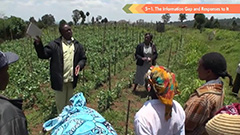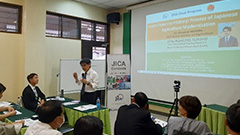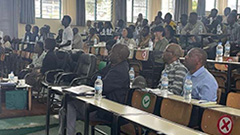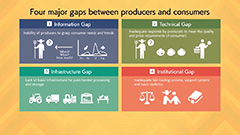Agricultural development to improve livelihood and income
Due to their efforts over the past several decades, many countries have moved away from a situation where the main goal of agriculture and food production was to eliminate hunger.
As a result, there is currently a strong interest in agricultural development to focus on improving livelihoods and incomes.
Through initiatives such as JICA-VAN*, I hold lectures in some universities in Japan and abroad every year.
Most of the lectures include the theme of agricultural value chain development. We are using the JICA-Net multimedia-based learning material “Agricultural support that responds to changes in the food value chain” (YouTube, external link)
.
*JICA-VAN (JICA Virtual Academy & Network) is a continuous mutual learning and knowledge sharing platform created for all stakeholders and beneficiaries of the JICA project. The objective is to promote learning and networking between people involved in international cooperation through LMS (Learning Management System) and SNS.
Explain the problems and the countermeasures of food value chain

The material explains by showing examples of JICA’s technical cooperation.
The majority of agricultural producers in developing countries face the same problem: despite working hard on the crop production, they are unable to sell them for a high price, making it difficult to escape poverty.
One solution is food value chain development.
Food value chain is a system in which stakeholders collaborate throughout the entire chain of agricultural products, from producer to consumer to add product value by enhancing productivity.
The material explains “Main Characteristics of a Food Value Chain and Four Major Gaps in it” in the first half and “Examples of Responses to the Four Major Gaps (Information, Technical, Infrastructure, Institutional)” in the second half by showing the examples of JICA’s technical cooperation and Japan’s experiences with many illustrations and photographs to make them easy to understand visually.
Use the material for the lectures in universities and JICA Knowledge Co-Creation Programs
Last year, the material was screened at the face-to-face lecture, “Learn from the history: Process of Japanese Agriculture Modernization”, at the Royal University of Phnom Penh (RUPP), Cambodia, April 28th, where 70 people participated, including students of faculty of development studies of RUPP, JICA ex-participants and experts of the agricultural sector. Also at the face-to-face lecture held on August 30th in The University of Rwanda-College of Agriculture Animal Sciences and Veterinary Medicine (UR-CAVM), Rwanda, whose themes were “How Agriculture contribute to Food Security and Rural Development” & “Agriculture Value Chain”, where about 130 people participated, including students who had a degree or master’s degree, doctoral students, instructors and JICA experts.

Nakada, JICA Senior Advisor, answers participants' questions (Royal University of Phnom Penh, Cambodia).

Participants listening to the lecture eagerly (University of Rwanda-College, Rwanda).
We used the material as follows: Firstly, at the beginning of the 90-minute lecture, we screened the 30-minute video material so the participants could understand the outline of value chain development and Japan’s experiences. Then, through group work, they compared and analyzed the circumstances of each country and discussed the future direction of development.
We also use the material in some JICA Knowledge Co-Creation Programs (KCCP) on value chain in the same way.
A material that enables efficient sharing of knowledge and experience.
The advantage of video material is that by sharing basic knowledge and experiences through it, allows participants to focus on specific discussions and group work during the lectures.
If they have time, you can have them watch the material in advance.
I also attempted to use the material online last year by using a tool that allows uses to watch a video on a website and perform a simple assurance test.
This year, using this tool, I think the material in KCCP could be used as pre-learning for the trainees to get a basic understanding before visiting Japan so that they can learn and discuss smoothly the subject after their arrival.
I hope that knowing the examples of JICA’s support and Japan’s experiences through the material will help them to think of a value chain development suitable for their own countries.

Sharing basic knowledge and experiences through the video.
NAKADA Shunichi
Senior advisor
JICA Economic Development Department
*The Material(s) mainly applied
Agricultural support that responds to changes in the food value chain
This video presents the value chain structure that is changing with technological developments and shifting consumer preferences in the agriculture and food industries, and the policy support that should be provided in light of these changes.
1. What is Food Value Chain Development?
2. Key factors affecting the supply side
3. Key factors affecting the demand side
4. Four major gaps in value chain development
(information, technology, infrastructure, and institutions)
JICA have been supporting food value chain development in developing countries making use of Japanese experiences.
This includes cases in which farmer doubled their income in a short period.
Food value chains evolve along with factors like technological development and transition of consumer preferences.
This video looks at agricultural support that responds to such changes.




scroll